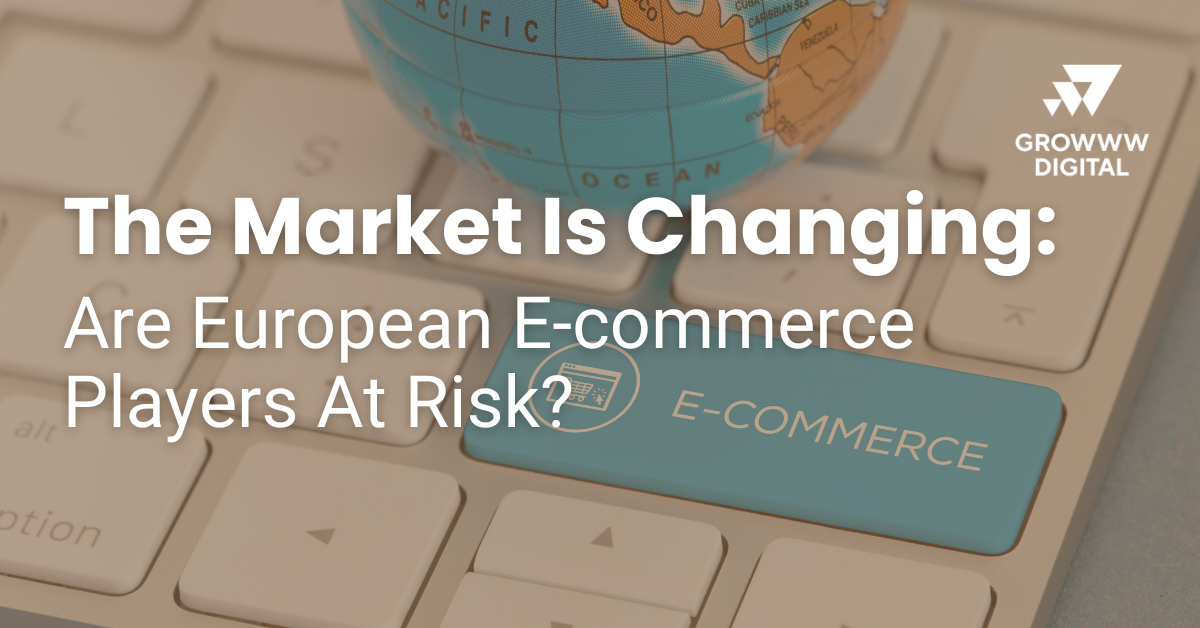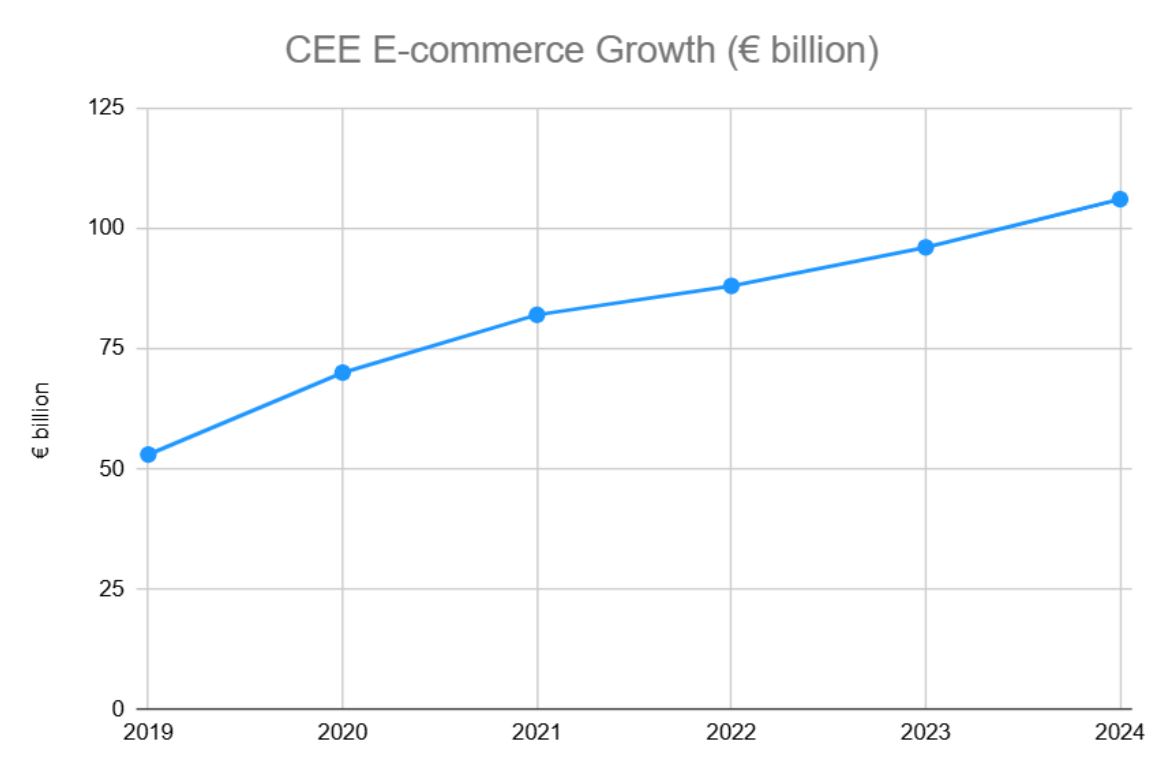
The Market Is Changing: Are European E-Commerce Players At Risk?
The Market Is Changing: Are European E-Commerce Players At Risk?
Based on the European E-Commerce Report 2024, we have summarised the key European and Central-Eastern European trends. Additionally, we highlight aspects to help navigate the current e-commerce market.
European e-commerce experienced growth in 2023, with revenues increasing by 3% to reach €887 billion. However, regional disparities significantly influenced the sector’s performance, prompting many to call for urgent EU-level intervention.
Inflation, international competition, mainly the expansion of Asian players, and the ongoing challenges of digital and green transitions are pressuring the sector. This is especially true for Central and Eastern European (CEE) countries, where e-commerce is rapidly evolving but still has substantial room for growth and development.

Source: European E-commerce Report 2024
Central and Eastern Europe: Market Overview
Although Central and Eastern European countries have seen rapid growth in recent years, the region accounts for only 11% of the total European e-commerce revenue. By comparison, Western Europe holds a 64% share, indicating significant opportunities for digital growth in CEE.
In 2024, e-commerce growth in the CEE region is expected to reach 12–13% compared to 2023. Notably, Eastern and Balkan countries are growing nearly twice as fast as countries like the Czech Republic, Slovakia, or Hungary in the western part of the region.
Major Challenges for CEE E-Commerce
- Inflation and Declining Purchasing Power: Rising inflation has reduced consumer purchasing power, slowing e-commerce growth. While there is increasing interest in sustainable products, many consumers are unwilling to pay premium prices for them.
- Competition and Regulation: Strong competition from non-EU companies, particularly from Asia, poses challenges for local businesses. To ensure fair competition, experts stress the importance of effective EU regulations, particularly concerning international platforms.
- Digital and Green Transition: EU goals emphasise the creation of a digital and sustainable economy. E-commerce players must adapt to more sustainable packaging and logistics solutions and invest in digital innovation.

Source: European E-commerce Report 2024
Want to expand in the region? Download Your Free Ultimate CEE Ecommerce Export Guide!
75 pages packed with all you need to know as an ecommerce business before you expand to Czechia, Slovakia, Hungary, Romania, Croatia and Slovenia.
“The era of global e-commerce has arrived—Europe is now competing with Asia and America for customers. It is of strategic importance for e-commerce businesses to follow the path of least resistance under the pressure to grow: by expanding their product portfolios and channel mix, and pursuing international expansion. This is the recipe for growth, and the strategies of major players are also built on this foundation.”
– László Szabó, Managing Partner, Growww Digital
The EU’s Role and Regulatory Environment
Many European experts advocate for stronger regulatory measures to address competition from non-EU companies and for creating a stricter regulatory framework applicable to all market participants.
For the growth of the European digital economy, it is essential to support small and medium-sized enterprises (SMEs) in their digital transition and ensure they have access to the resources necessary to compete with larger e-commerce businesses.
Key Trends in CEE E-Commerce
- The Rise of Mobile Payments and Digital Wallets: Mobile payment solutions are gaining popularity in the region, especially in Poland and Hungary, where e-wallets are a rapidly growing segment. Consumers value convenient, secure, and fast payment options, driving adoption.
- Cross-Border Shopping: More consumers in the region are purchasing from foreign online stores. Czech and Polish shoppers often order from other EU countries, while Romanian and Hungarian consumers are increasingly open to cross-border online shopping, though logistical and shipping costs remain obstacles.
- Sustainable Shopping and Packaging: EU regulations are encouraging demand for sustainable products and packaging. Many local businesses are beginning to offer eco-friendly packaging solutions as they adapt to these trends.

Source: European E-commerce Report 2024
Future Outlook and Expected Trends
Forecasts suggest that European e-commerce will continue to grow, driven primarily by digital innovation and the expansion of mobile payment solutions. For the CEE region, it will be crucial for local companies to embrace the digital transition and capitalise on cross-border trade opportunities.
- Supporting Innovation: Technological development is vital for maintaining competitiveness. Countries like Poland and the Czech Republic are providing state support to encourage digital development among SMEs.
- Logistics Improvements: Developing more efficient logistics solutions can help reduce shipping costs, facilitating an increase in cross-border purchases. Enhanced logistics infrastructure is particularly needed in Eastern Europe to bring e-commerce closer to Western European standards.
- Supporting Green Transition: EU regulations will continue to prioritise sustainability. E-commerce companies can leverage this by adopting greener packaging solutions and reducing the volume of returned products.
Growth Strategies for CEE E-Commerce Players
CEE merchants can improve their market position by exploring new opportunities and taking strategic steps:
- International Expansion: Entering foreign markets after thorough research and validation offers one of the most direct routes to revenue growth. However, this strategy requires patience, as it typically takes 1–3 years to reach the break-even point.
- Product Line Expansion: Broadening product offerings can be implemented relatively quickly, allowing merchants to leverage existing expertise and resources.
- Channel Diversification: Expanding presence across marketplaces, price comparison sites, social platforms, and alternative communication platforms can boost visibility and sales.
- Omnichannel Strategies: For omnichannel players, building a strong digital pillar is no longer about growth but survival. In today’s competitive market, online sales and marketing channels are indispensable.
Conclusion
European e-commerce grew by 3% in 2023, reaching €887 billion in revenue, but regional differences shaped the market. While the CEE region has dynamic growth potential, it still lags significantly behind Western Europe.
The sector faces considerable challenges, such as inflation, the rise of Asian competitors, and digital and sustainability transitions. Success will require technological innovation, logistics improvements, sustainable practices, a robust regulatory environment, and leveraging cross-border trade opportunities.
Want to expand in the region? Download Your Free Ultimate CEE Ecommerce Export Guide!
75 pages packed with all you need to know as an ecommerce business before you expand to Czechia, Slovakia, Hungary, Romania, Croatia and Slovenia.
